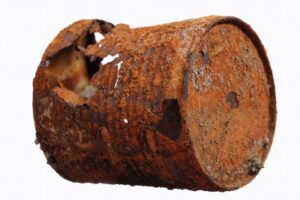The topic of corrosion makes recurring appearances in the media; it seems that when you hear about one corrosion-related problem, invariably there will be others reported-on at around the same time. There has recently been a spate of articles confirming that corrosion is currently a headache to the oil and gas sector (undersea bolt failures), as well as to the aviation sector (corrosion-induced fatigue of turbine engine blades in the new Dreamliner aircraft). Oftentimes these stories are first published by financial-leaning news outlets (Wall Street Journal, CNN Money, Bloomberg), a result of the high visibility and cost that these incidents bring in terms of replacement and downtime to their respective industries. Enough of these stories circulating over the span of a few news cycles will make any investor wary, and will prompt questions on what is being done from a regulatory standpoint to restore confidence in companies’ operations. This is particularly true when these reports of corrosion failures have impacts (real, or perceived) on public and environmental safety.
Of course, corrosion is not a new phenomenon. We have been observing the process of corrosion for centuries in our manmade structures, and have developed ways to physically mitigate its effects (painting, inspection methods, et cetera). However, it has only been in recent history that we a) have deeper understanding of the electrochemical processes that describe corrosion, and b) have the industrial engineering prowess to design and build ever greater machines and superstructures that help make modern life possible (economically-available energy sources and air travel, being prime examples). The confluence of these two factors drive the need for more development of mechanistic approaches to corrosion mitigation, through the use of computer-assisted modeling and simulation.
To that end, more and more resources are being appropriated for the research of these corrosion mechanisms in many of the materials that are used today. For example, members of the LIFT Consortium (Lightweight Innovations for Tomorrow) have begun work on the development of new models and a material properties database that will allow for more accurate simulations of corrosion in aluminum alloys used in aerospace and other transportation sectors (focusing on aluminum alloys containing copper, lithium, magnesium, manganese, and zinc). The materials database will be characterized to such a degree so that precise information is obtained about the interaction between microstructure and corrosion. The team will begin with the characterization of the industry’s workhorse alloys, and then extend work to evaluate newer alloys crated using various manufacturing techniques. The goal is to mitigate corrosion in a broad spectrum of aluminum alloys through improved simulator capabilities.
However, only half of the equation is being studied by LIFT: the corrosion impact on metals…with no discussion of how that corrosion introduces damage states, from which stress corrosion cracking and other types of corrosion-fatigue can arise. VEXTEC has pioneered development of a software for the U.S. Navy that predicts the statistical distribution of stress corrosion cracking in an alloyed aluminum microstructure that has been exposed to a corrosive environment. This software serves as a basis for all types of materials that are impacted by corrosion: the material modelers can provide the inputs of the corroded damage states into the VEXTEC software, which will in turn simulate the result of in-service loading on the durability of the critical structures of interest.
Until such time as corrosion has been completely removed as a mechanism in a critically-stressed component (and that time is not approaching anytime soon), it isn’t enough to just model the corrosion characteristics…we must also be able to effectively model the subsequent damage growth throughout the component’s service life.





Leave A Comment